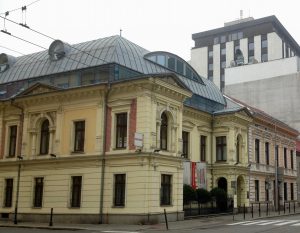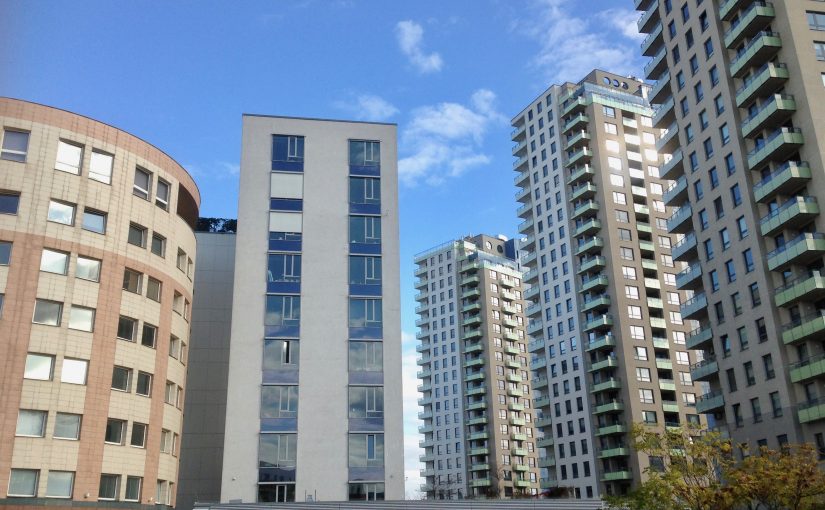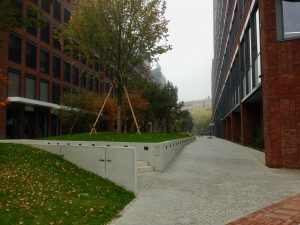Last night, I slept ten hours despite having napped for three yesterday afternoon, and I’m happy to report that improved navigation-of-bed-and-sofa skills survived to see daylight. Even more significant, the lower back pain that has been quirkily haunting various movements since April, is, as of this morning, gone. (Here, the metaphor of a theatrical quick fade to black may be used.) I had no expectations of the FMT helping back pain, but when I told Michele the Shiatsu Genius what I was up to in Bratislava, he commented that lower back problems are often linked to intestinal imbalances. What a nice surprise and unexpected encouragement.
So because clenchings and discomforts were at a minimum, I early determined my daily walk would be in the direction of Centrum – the old city. What kept me from starting at nine was damp, chill weather and fear of being far from known sanitary facilities. Also, this morning’s goofiness was strong, and though I knew walking would at least reduce it, I worried about the stairs down to the sidewalk. But you don’t explore frontiers by staying home, so at about eleven I threw fate to the vagaries of my bladder, and set off in the direction the friendly gardener had indicated day before yesterday. The sidewalk was reached without the least bit of difficulty, and as I approached the Silicon Valley-esque Business Center, I had already hit stride.
I arrived in Centrum sans urinary emergencies, but by then was reeling from hunger. English pubs, German beer halls, and Hungarian deli’s abound in the old city, all with establishment dates in the 1800’s, but I wanted Slovak. I found a place called Grandmother’s Table (in Slovak, German, and English). Just inside the entrance is a huge crystal chandelier. To its left, a grotesque mural of historical characters feasting and singing, redolent of a Hogarth print. Everyone’s grandmother is different, I guess. Waitstaff were good, if not at all concerned with charm, and the menu heavy on… well, heavy. I picked out cabbage soup and stuffed potato dumplings. I won’t have to eat supper.
After lunch I monitored energy reserves, strolled briefly, then turned towards home. If I can, I’ll do the historic district again tomorrow, with a lighter lunch, and tell you all about it.
The districts outside of Centrum are, at first level, a mix of nineteenth century elegant – what was not bombed by the Allies, or unreasonably replaced by the locals – and mid to late twentieth century kitsch. (A sweeping generalization, but the overall effect is rather glum). Then there is an intermediary layer of grandiose corporate glass and aluminum, including huge construction projects across from the bus station (which itself looks fairly new) that seem to include a new metro center. This city has money and big ideas.
Then we come to the Nivy neighborhood, where I live, with its mid-century brutal blocks of solid socialist housing (that, to be fair, may have represented a huge improvement in comfort when they went up) and sleek and sassy attempts at modernist whimsy mixed with get-it-up practicality. But you know, somehow, the neighborhood’s architecture has improved over the past week. The building I’m in is not without its charms — even if it tries a bit too hard — and offers me a cozy home. The one directly across the narrow lane from this morning’s dreaded entry stairs is an interesting mix of geometric shapes cobbled together in ways both surprising and pleasing. The apartment towers viewed from my balcony are handsome against a blue sky, and yesterday, if I squinted hard, I could spot a few plants on balconies. Last night I noticed that most floors were dark, so maybe lack of plants is a by-product of lack of occupants.
Nearby, there is a wide boulevard from the communist era with a parkway between its two narrow lanes and three rows of majestic trees. The buildings are without grace, but most are freshly painted, and if you don’t focus on specifics, the whole is quite pleasant. That leads to a neighborhood of independent homes and small apartment blocks with twisty streets and pitched roofs. I suspect it may have been a village for party apparatchik.
Public transportation includes electric trolley-busses, trams, light rail, commuter rail, articulated pullmans, and according to the fellow I sat next to on the way from Vienna airport, an underground bus system is in the works. (Where I come from we call it a subway, but those are trains, not busses. Maybe it was a language thing.) And yes, there are thousands of cars. In these outlying districts, more space seems to be devoted to cars than to people. But in my neighborhood, there are also hundreds of young folk on foot. Even on the major thoroughfares I pass mothers pushing trams, bicyclists of all stripes, student groups, and strolling couples. No tourists, though. Except for me.
Since the walk, I napped for an hour and have drunk liters of whatever I could find to guzzle. I guess lunch was not low-sodium.

MY BRATISLAVA Parte Uno (di due)
Ieri sera ho dormito dieci ore nonostante sia stato riposato per tre ieri pomeriggio, e sono felice di riferire che sono migliorate le capacità di navigazione del letto e del divano per vedere la luce della alba. Ancora più significativo, il dolore lombare che ha stranamente perseguitato vari movimenti da aprile, è scomparso da questa mattina. (Qui, può essere usata la metafora di una dissolvenza rapida teatrale verso il nero.) Non avevo aspettative che la FMT aiutasse il mal di schiena, ma quando ho detto a Michele lo Shiatsu Genius che cosa stavo facendo a Bratislava, ha commentato che i problemi alla schiena sono spesso collegati a squilibri intestinali. Che bella sorpresa e inaspettato incoraggiamento.
Quindi, poiché le contrazioni e i disagi erano al minimo, ho presto capito che la mia passeggiata quotidiana sarebbe stata in direzione di Centrum , la città storica. Ciò che mi ha impedito di iniziare alle nove era l’umidità, il freddo e la paura di essere lontani dai servizi sanitari conosciuti. Inoltre, il goffo di stamattina era forte, e sebbene sapessi che almeno lo avrei camminato, mi preoccupavo delle scale che portavano al marciapiede. Ma non esplori le frontiere restando a casa, quindi verso le undici ho gettato il destino ai capricci della mia vescica e sono partito nella direzione indicata dall’amichevole giardiniere l’altro ieri. Il marciapiede fu raggiunto senza la minima difficoltà, e mentre mi avvicinavo al Business Center in stile Silicon Valley, avevo già fatto passi da gigante.
Sono arrivato a Centrum senza emergenze urinarie, ma a quel punto si stava barcollando dalla fame. Pub inglesi, birrerie tedesche e gastronomie ungheresi abbondano nella città vecchia, tutte con date di fondazione nel 1800, ma volevo slovacco. Ho trovato un posto chiamato Tavolo della nonna (in slovacco, tedesco e inglese). Appena dentro l’ingresso c’è un enorme lampadario di cristallo. Alla sua sinistra, un murale grottesco di personaggi storici che banchettano e cantano, che ricorda una stampa di Hogarth. La nonna di tutti è diversa, immagino. I camerieri erano buoni, se non affatto interessati al fascino, e il menu era pesante di… beh, cibo pesante. Ho scelto la zuppa di cavolo e gli gnocchi di patate ripieni. Non dovrò mangiare la cena.
Dopo pranzo ho monitorato le riserve energetiche, ho passeggiato brevemente, poi mi sono girato verso casa. Se posso, domani farò di nuovo il quartiere storico, con un pranzo più leggero, e ti racconterò tutto.
I quartieri fuori Centrum sono, al primo strato, una mista di eleganza del diciannovesimo secolo – ciò che non fu bombardato dagli Alleati o irragionevolmente sostituito dai locali – e il kitsch dalla metà alla fine del ventesimo secolo. (Una generalizzazione indiscriminata, ma l’effetto complessivo è piuttosto fiacco). Poi c’è uno strato intermedio dello stile aziendale grandioso del vetro e alluminio, tra cui enormi progetti di costruzione di fronte alla stazione degli autobus (che a sua volta sembra abbastanza nuova) che sembrano includere un nuovo centro della metropolitana. Questa città ha soldi e grandi idee.
Poi arriviamo nel quartiere di Nivy, dove vivo, con i suoi brutali blocchi della metà del secolo di solidi alloggi socialisti (che, per essere onesti, potrebbero aver rappresentato un enorme miglioramento nel comfort) e tentativi eleganti e impertinenti di modernismo stravagante mescolato con “get-it-up” pratico. Ma sai, in qualche modo, l’architettura del quartiere è migliorata nel corso dell’ultima settimana. L’edificio in cui mi trovo non è privo di fascino, se ha bisogno di una verniciatura e mi offre una casa accogliente. Quello direttamente dall’altra parte della stradina dalle temute scale d’ingresso di questa mattina è un interessante mix di forme geometriche acciottolate in un modo sorprendente e piacevole. Le torri degli appartamenti viste dal mio balcone sono belle contro un cielo blu e ieri, se strizzavo gli occhi, avrei potuto individuare alcune piante sui balconi. Ieri sera ho notato che la maggior parte dei piani era buia, quindi forse la mancanza di piante è un sottoprodotto della mancanza di occupanti.
Nelle vicinanze, vi è un ampio viale di epoca comunista con un parco tra le sue due strette viuzze e tre file di alberi maestosi. Gli edifici sono senza grazia, ma la maggior parte sono dipinti di fresco, e se non ti concentri su dettagli, il tutto è abbastanza piacevole. Ciò conduce a un quartiere di case indipendenti e piccoli palazzi con strade curvose e tetti spioventi. Ho il sospetto che potrebbe essere stato un villaggio per apparatchik del partito.
Il trasporto pubblico comprende filobus elettrici, tram, metropolitana leggera, pendolari, pullman articolati e, secondo il uomo affianco cui mi sono seduto dall’aeroporto di Vienna, stanno costruendo un sistema di autobus sotterraneo. (Da dove vengo la chiamiamo una metropolitana, ma quelli sono treni, non autobus. Forse c’era un problema linguistico.) E sì, ci sono migliaia di macchine. In questi quartieri periferici, sembra che più spazio sia dedicato alle automobili che alle persone. Ma nel mio quartiere ci sono anche centinaia di giovani a piedi. Persino sulle principali arterie passo madri che spingono tram, ciclisti di ogni genere, gruppi di studenti e coppie che passeggiano. Nessun turista, però. Eccetto per me.
Dopo la passeggiata, ho fatto un pisolino per un’ora e ho tracannato litri di tutto ciò che sono riuscito a trovare. Immagino che il pranzo non fosse a basso contenuto di sodio.

